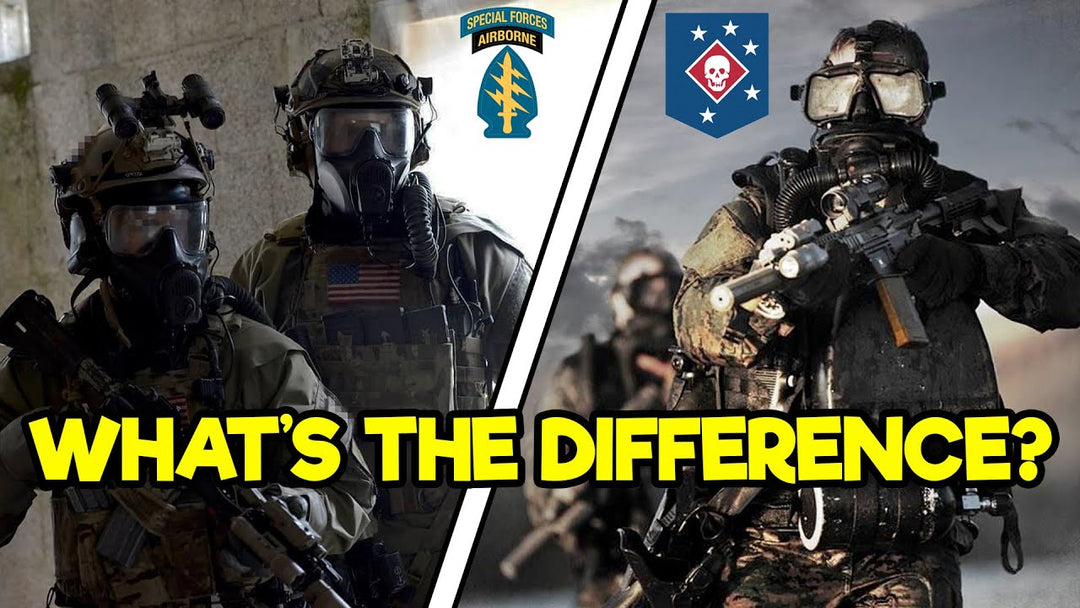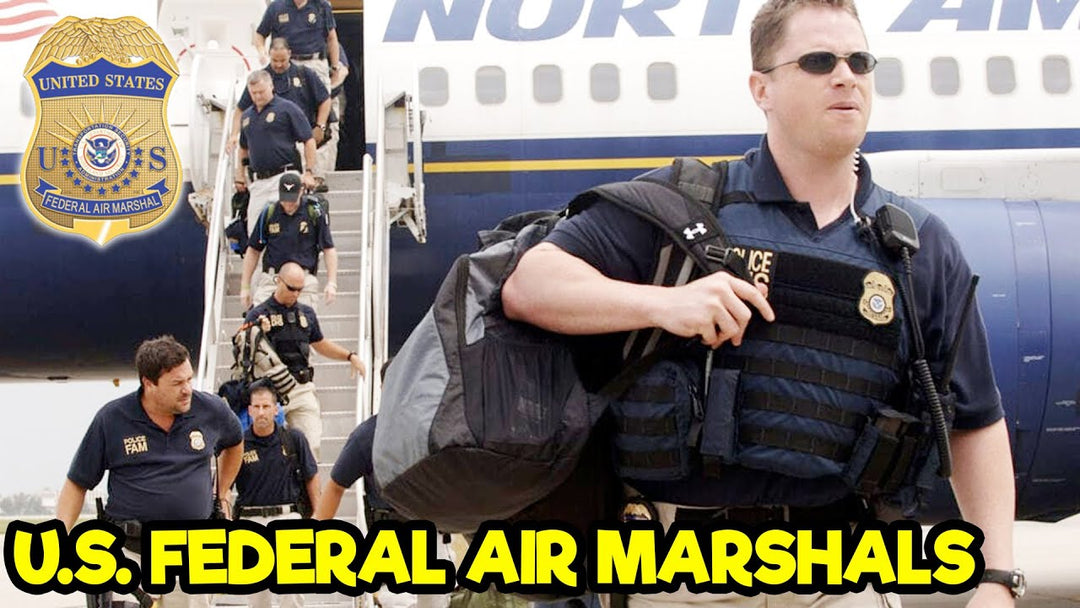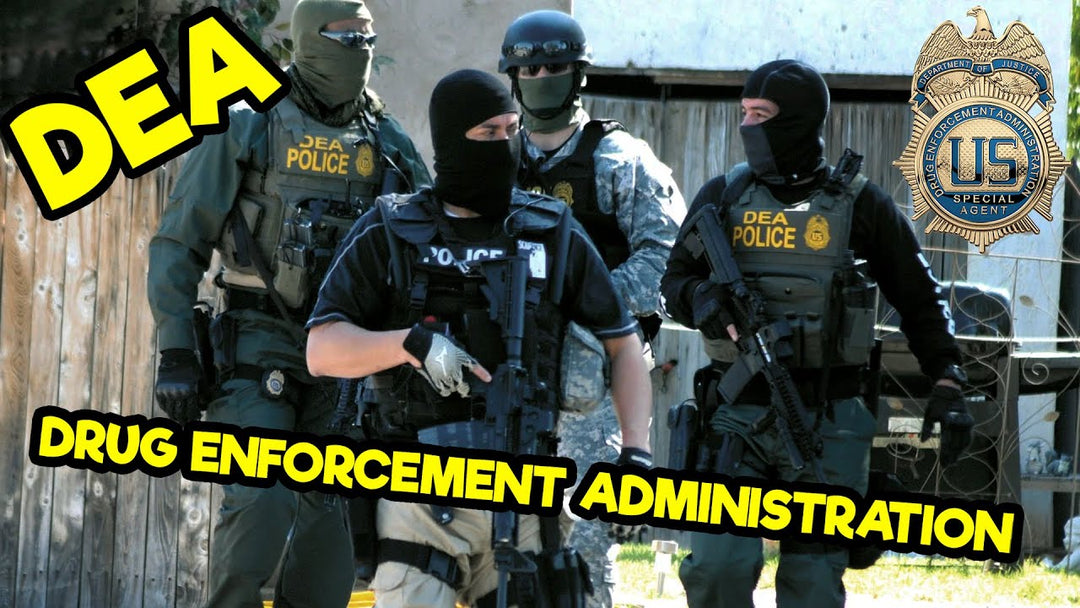Federal Law Enforcement Tactical Units - Why Are There So Many?

When most people think of special operations, they think of Navy SEALs, Green Berets, or even the MARSOC Raiders. But little do people know that law enforcement has a plethora of special operations units that are on par with some SOF forces. In fact, where do you think a lot of operators go once they get out of the military?
Law Enforcement has a wide array of special operations units that are highly trained and specialized to operate both domestically and internationally. With such a large scope to cover, and given that law enforcement is broken down into Federal, State, and Local police, we’re just going to be focusing on the Federal special operations units to give you a taste of what types of units are out there.
This begs the question, why does the Federal government have so many tactical units? What’s the point? To answer those questions, we’re going to be covering seven units that we believe will showcase not only their unique purpose in federal law enforcement, but also bring you into the bigger picture as to why so many exist.
The seven units we will be highlighting on this blog post are the FBI HRT, Marshals SOG, DEA SRT, BORTAC, Secret Service CAT, DSS MSD, and BOP SORT. This is: Federal Law Enforcement Special Operations.
TABLE OF CONTENTS
FEDERAL LAW ENFORCEMENT TACTICAL UNITS: FBI HOSTAGE RESCUE TEAM
FEDERAL LAW ENFORCEMENT TACTICAL UNITS: MARSHALS SPECIAL OPERATIONS GROUP
FEDERAL LAW ENFORCEMENT TACTICAL UNITS: DRUG ENFORCEMENT AGENCY SPECIAL RESPONSE TEAM
FEDERAL LAW ENFORCEMENT TACTICAL UNITS: BORDER PATROL TACTICAL UNIT
FEDERAL LAW ENFORCEMENT TACTICAL UNITS: SECRET SERVICE COUNTER ASSAULT TEAM
FEDERAL LAW ENFORCEMENT TACTICAL UNITS: DIPLOMATIC SECURITY SERVICE MOBILE SECURITY DEPLOYMENTS
FEDERAL LAW ENFORCEMENT TACTICAL UNITS: FEDERAL BUREAU OF PRISONS SPECIAL OPERATIONS RESPONSE TEAMS
FEDERAL LAW ENFORCEMENT TACTICAL UNITS: CONCLUSION
FEDERAL LAW ENFORCEMENT TACTICAL UNITS: FBI HOSTAGE RESCUE TEAM

Hostage situations are high stress, high stakes, intense missions that can go wrong at a moment's notice. With thousands of hostage-taking incidents occurring every year in the United States, there is a strong need for highly capable law enforcement units to get the job done. Out of these hostage rescue units, the FBI Hostage Rescue Team is often considered the best of the best.
FBI HRT is trained to be able to operate in and respond to the most high-risk environments and conditions imaginable. But hostage rescue isn’t the only thing HRT specializes in. Since its inception, it has been deployed to over 850 incidents, which involved missions ranging from terrorism to violent crimes to foreign counterintelligence. It has the ability to deploy anywhere within the United States in just four hours, but don’t think their influence stops inside the country. They’ve been involved in overseas deployments, and have been known to embed in the U.S. military’s special operations units.
And, with the FBI’s 56 SWAT teams and 14 enhanced SWAT teams, the HRT gets the most advanced equipment out of the bunch. But don’t think it ends with the equipment, they’re also the tip of the spear when it comes to its operators. They’re trained in the full spectrum of combat, such as jumping, diving, breaching, VBSS—you name it.
HRT’s motto, “Servare Vitas," which translates as “To Save Lives,” represents one of their most important roles.
FEDERAL LAW ENFORCEMENT TACTICAL UNITS: MARSHALS SPECIAL OPERATIONS GROUP

You just robbed a bank and are trying to make a dash to Mexico to avoid arrest? If the U.S. Marshals Special Operations Group is after you, you can run, but you’ll get caught tired. There’s nowhere to hide with the Marshals SOG.
Out of all of the U.S. federal tactical units out there, the Marshals SOG is the first of its kind. They are a versatile force that is capable of executing a wide range of law enforcement missions in any environment, both within and outside the United States. They are one of the first ones called when there’s a high profile criminal on the loose. Dealing with high threat arrests and search warrants is the Marshals bread and butter, and SOG is tasked with catching the most dangerous of the dangerous.They often deal with the Marshals Service Top 15 most wanted, and if you go take a look at who’s on that list, it’s a good thing that these guys are the ones after them.
But there’s more to SOG than hunting for fugitives. They have their hand in judicial security, witness security, national emergencies, and whatever the attorney general tasks them out to do.
Each member is thoroughly trained in every facet you can think of when it comes to this line of work. They’re trained in helicopter insertions, rappelling, use of diversionary/distraction devices, close quarters combat, tactical field training, tactical movement, and receive extensive weapons and firearms proficiency training.
FEDERAL LAW ENFORCEMENT TACTICAL UNITS: DRUG ENFORCEMENT ADMINISTRATION SPECIAL RESPONSE TEAMS

If you’ve watched the show Narcos, you should be familiar with the DEA. What the show doesn’t touch on is their Special Response Teams, and there’s a reason for that. First up, they didn’t exist at the time. And even if they did, the DEA’s SRT’s missions are kept under wraps, and not much is known about what they do. Founded in 2016, stemming from the DEA’s FAST Teams, DEA SRT performs high-risk operations in support of the DEA’s mission to enforce federal controlled substances laws and regulations.
DEA SRT’s main mission is to serve high-risk search and arrest warrants related to drug crimes. Drug dealers can be armed and dangerous, and the DEA needs a team of highly trained personnel who can take care of any situation that gets sticky.
Each major DEA domestic office maintains an SRT, which means that they are scattered throughout the country and can be mobilized and deployed to respond to incidents in a short amount of time. Dealing with high-risk search and arrest warrants isn’t all that they do, though. They also conduct vehicle assaults, air assaults and infiltrations, specialized surveillance, custody of high-profile individuals, dignitary and witness protection, tactical surveillance and interdiction, advanced breaching, tactical training for other police units, and urban and rural fugitive searches.
They continue to participate in missions that most will never hear about. Due to the secrecy of their operations, DEA SRT is likely to continue to operate in the shadows and will have an impact on the war against drugs.
FEDERAL LAW ENFORCEMENT TACTICAL UNITS: BORDER PATROL TACTICAL UNIT

Contrary to popular belief, the Border Patrol does more than just patrol the border. Would it surprise you to learn that they have an elite tactical team that has not only operated across the country, but has also played a significant role in international missions as well? That would be BORTAC, which stands for Border Patrol Tactical Unit. BORTAC plays an important role not only in augmenting the capabilities of the DHS regarding terrorist threats and incidents, but in all aspects of traditional Border Patrol Operations.
BORTAC gives the DHS an immediate-response capability for emergent and high-risk incidents both nationally and internationally. With units in all of Border Patrol’s 13 sectors, both on the northern and southern border, BORTAC can be deployed immediately wherever they are needed. Its main missions include high-risk warrant service, surveillance, and foreign law enforcement capacity building. If you don’t know what that means, it's essentially training other law enforcement entities in order to further expand their capabilities.
All BORTAC members are experts in small unit tactics, operational planning, advanced weapon skills, defensive tactics, and airmobile operations. Going beyond that, each member has the ability to further develop their skills needed in furtherance of the BORTAC mission, and can receive training in maritime operations, work with military working dogs, become snipers, and much, much more.
FEDERAL LAW ENFORCEMENT TACTICAL UNITS: SECRET SERVICE COUNTER ASSAULT TEAM

Don’t get the wrong idea here, the secret service does not use cats to protect the president. CAT stands for Counter Assault Team, which does things a bit differently than the men in black you see standing around the president. Instead of just shielding the president from harm, the counter assault team goes on the offensive and diverts any potential assailant’s attention from the president as the rest of his detail attempts to safely evacuate him.
To put it simply, if someone or a group of people happened to target the president, and began an assault, the CAT would literally “Counter Assault” them, and become the main focus for the assaulters while the rest of the secret service is keeping the president safe and getting him somewhere else.
Needless to say, the CAT is equipped with a multitude of weapons and gear to make anyone trying to harm the president instantly regret their decision. But they’re not just tasked with protecting the president, they are also tasked with dealing with various VIP’s in the political realm as well as foreign heads of state.
When they’re not training or counter assaulting, they provide support and security for National Special Security Events, such as presidential inaugurations. They also survey each site beforehand to ensure it is good to go before they are visited, and from the information they gather, they determine the manpower, equipment, hospitals, and evacuation routes in case of emergencies. Let’s just say, they’re some pretty good bodyguards.
FEDERAL LAW ENFORCEMENT TACTICAL UNITS: DIPLOMATIC SECURITY SERVICE MOBILE SECURITY DEPLOYMENTS

Twenty-four hours a day, domestically and overseas, when the U.S. Department of State needs help, their Mobile Security Deployments answer the call.
The Diplomatic Security Service plays an important role in protecting members of the federal government and dignitaries both domestically and abroad. However, the DSS operates more so on foreign soil than domestically. The contrast gets even bigger when it comes to their Mobile Security Deployments, with only 10% of MSD’s missions being conducted in the United States.
So what exactly does MSD do? While this is by no means a limitation on what they’re capable of, their primary missions are crisis response and evacuation operations, high threat protection, facility security augmentation, and joint training and deployments with other specialized units.
They accomplish these missions through their Mobile Training Teams, Security Support Teams, and Tactical Support teams. Each plays a vital role in the MSD. The MTT’s are the ones training and augmenting other security personnel at embassies, such as the Marine Security Guards. Their SST’s are trained for counterattacks on U.S. embassies or threats against diplomatic personnel, and their numbers have only grown since the Benghazi attacks in 2012.
The TST’s are the ones geared up as more of a heavily armed reaction force in support of the protective service details assigned to high-profile VIP’s, like the Secretary of State.
Needless to say, MSD’s missions are extremely and inherently dangerous, meaning that each member is extensively trained to be an effective team member, acquiring skills such as advanced firearms training, dynamic room entry, helicopter operations, high risk survival training, and defensive tactics.
FEDERAL LAW ENFORCEMENT TACTICAL UNITS: FEDERAL BUREAU OF PRISONS SPECIAL OPERATIONS RESPONSE TEAMS

The need for federal special operations units doesn’t end once the perpetrator is arrested. Once they’re incarcerated, there’s a strong need to keep order in the various federal institutions throughout the country. That’s where BOP SORT comes in. Formally known as the Federal Bureau of Prisons Special Operations Response Teams, BOP SORT consists of some of the most professional and capable personnel in the world of corrections.
Prisons can get rowdy. If a large-scale riot were to occur in one of the federal government’s prisons, SORT would be deployed to fix the situation. But they’re also called to respond to other day-to-day situations that can arise at a moment’s notice, such as assaults on staff or inmates, escapes or attempted escapes, and hostage situations, and believe it or not, their influence goes outside of the prison’s walls. If needed, they can respond to any terrorist or military strike on the United States.
SORT members are typically experienced correctional officers who have years under their belt in that line of work. They’re familiar with their facility, they’re no strangers to supervising inmates, and they’re not afraid to get their hands dirty. However, being a part of SORT is a part-time gig. BOP officers will conduct their normal day to day duties, and when needed, they will gear up for SORT. Every SORT member is equipped with a work phone and is on call to respond if necessary.
A typical SORT has 15 members. Of these members, they have an emergency medical treatment specialist, a firearms instructor, a rappel master, a security/locking systems expert, a blueprint expert, a sniper/spotter team, a chemical agents specialist, and several firearms and tactical planning/procedures experts. All of these work in tandem, supplemented by Disturbance Control Teams and Hostage Negotiation Teams, to respond to high-risk scenarios. As you can see, there’s a lot of talent in SORT teams that enables them to be an effective force.
FEDERAL LAW ENFORCEMENT TACTICAL UNITS: CONCLUSION

You’ve just learned about seven of the various Federal law enforcement special operations units. You may have noticed some overlap between these units in terms of capabilities and missions, but each has a distinct purpose for the departments they serve under. Various law enforcement units work in tandem to enforce the law of the United States, and each federal law enforcement agency has their own nuances and areas of responsibility, so respectively, their special operations units will typically reflect and pursue those specific missions and responsibilities. At the end of the day, each unit brings a unique perspective and talent to the world of federal law enforcement tactical units.
There are many more federal tactical units than the ones we covered in this blog post. We’d encourage you to do your research on them. On top of Federal, there are also state and local units. If you’re confused about why there are so many different types of Law Enforcement, don’t worry, we’ve done a blog post explaining why!
If you want to learn more about the military, law enforcement, or government entities, we have a YouTube channel dedicated to providing the best info out there, plus we have a growing list of blog posts as well. Click the links to take you to them!
General Discharge is a veteran-owned, veteran-operated organization that is dedicated to providing the best U.S. Military and Law Enforcement information. With over 250 YouTube videos, over 45 million views, and hundreds of thousands of followers, we have contributed to the success and knowledge of both the current and future generations of service members.






Leave a comment